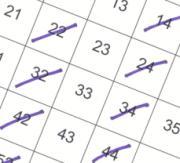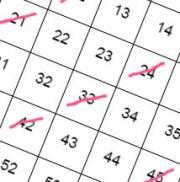Sieve of Eratosthenes
Follow this recipe for sieving numbers and see what interesting patterns emerge.
Problem
Sieve of Eratosthenes printable sheet
Printable grids - small 2-100 grids, 2-100 master grid, six-column grid, 2-400 grid
You will need to print one copy of this 2-100 master grid, and a copy of this sheet of smaller grids.

On the first small grid, shade in all the multiples of 2 except 2.
- What do you notice? Can you explain what you see?
- Now update the master grid, by crossing out the multiples of 2 except 2.

On the second small grid, shade in all the multiples of 3 except 3.
- What do you notice? Can you explain what you see?
- Before you update the master grid, can you predict what will happen? Will you cross out any numbers that are already crossed out? If so, which ones?
- Now update the master grid, by crossing out the multiples of 3 except 3. Can you explain why some numbers have been crossed out twice and others only once?
Use the next four small grids to explore what happens for multiples of 4, 5, 6 and 7.
- Before you shade in the multiples of each number (but not the number itself), try to predict what patterns might emerge.
- After you have shaded in the multiples, try to explain the patterns you've found.
- Before you update the master grid, try to predict what will happen. Will you cross out any numbers that are already crossed out? If so, which ones?
- After you have updated the master grid, try to explain why some numbers have been crossed out again and others haven't.
Now look at the master grid. What is special about the numbers that you haven't crossed out?
What would change on the master grid if you were to cross out multiples of larger numbers?
We're used to working with grids with ten columns, but you might find an interesting result if you use this six-column grid instead. Can you predict what you will see? Try it!
Imagine you want to find all the prime numbers up to 400.
You could do this by crossing out multiples in a 2-400 number grid.
Which multiples will you choose to cross out?
How can you be sure that you are left with the primes?
(Here is a 2-400 number grid if you want to try it.)
Final challenge
Imagine you want to find all the prime numbers up to 1000 by crossing out multiples in a 2-1000 number grid.
Which number will you cross out last?
With thanks to Vicky Neale who created this task in collaboration with NRICH.
Getting Started
Multiples of 2 are: 2, 4, 6, 8, 10, ...
Multiples of 7 are: 7, 14, 21, 28, 35, ...
Student Solutions
Hannah, from Leicester High School for Girls, noticed that different patterns arose in her grid when she crossed out multiples of 2 and 3:
On the smaller grid all the multiples of 2 are in columns evenly spaced across the grid; this is because the grid is an even number of squares across. On the smaller grid, the multiples of three all go in diagonal lines. This is because the number of squares across in the grid is not a multiple of 3, it is a multiple of 10. This causes the numbers to shift one position to the left on each line, creating diagonal lines across the grid.
By analysing these patterns, she was able to predict what would happen when crossing out multiples of 4, 5 and 7. Hannah then correctly noticed that:
The key to knowing whether numbers will be crossed out several times or not depends on factors.
This was extended by Sam from Oakworth Primary School, who correctly said:
The numbers that haven't been crossed out are all prime numbers. Prime numbers are numbers that can only be divided by 1 and themselves.
For the final challenge, Hannah gave some very good reasoning:
The way to find all the prime numbers between 1 and 400 is by crossing out all the multiples of prime numbers between 1 and 20.
This is because the square root of 400 is 20, so, say we'd found the multiples of all the prime numbers below 20, and then we started trying to find the 23 times tables:
it would be a waste of time because it would just be the reverse of the multiples we'd found so far - e.g. $23 \times 2$ is the same as $2 \times 23$, which we did earlier, so we'd just be going back on ourselves.
It is a good idea to use prime numbers, because all non-prime numbers can be made as a product of prime numbers - this is called prime factorisation.
Well done also to Krystof from Prague who recognised that he only needed to check prime numbers smaller than 20.
This problem has existed since Eratosthenes first devised the algorithm in the 3rd Century BC. The unique prime factorisation of numbers is essential to many areas of mathematics.
Teachers' Resources
Why do this problem?
This problem offers students opportunities to explore multiples in more depth than usual, in particular looking at the links between multiples of different numbers. It also encourages students to see the connection between primes and multiples.
Possible approach
"What are the first few multiples of 2?"
"2, 4, 6, 8, 10, ..."
"And multiples of 7?"
"7, 14, 21, 28, 35, ..."
"Great. We'll be investigating properties of multiples today."
[Hand out sheets of smaller grids, one sheet per pair of students.]
"I'd like you to shade in all the multiples of 2 except 2, but before you do that, turn to your neighbour and try to predict what patterns you'll produce."
[Give them a minute to make predictions and do the shading. Emphasise that there is no need for beautiful shading.]
"I'd like you to shade in all the multiples of 3 except 3. Again, before you do that, turn to your neighbour and try to predict what patterns you'll produce."
[Give them a couple of minutes to do this.]
"Were your predictions correct? Why did you make those predictions?
Can you explain why you get different patterns for multiples of 2 and multiples of 3?"
"Now let's think about what happens when we combine these multiples."
[Hand out master grid, with multiples of 2 already crossed out.]
"We'll use this as our master grid to keep a running record of our findings. It's already got the multiples of 2 crossed out. Before you cross out the multiples of 3, can you and your partner predict what will happen? Will you cross out any numbers that are already crossed out? If so, which ones?"
[Give them a couple of minutes to work on this, and then ask them to report back.]
"What am I going to ask you to do next?"
"OK, so now explore what happens for multiples of 4, 5, 6 and 7. Before you shade in the multiples on the small grids, try to predict what patterns might emerge. After you've shaded in the multiples, try to explain the patterns you've found.
Before you update the master grid, try to predict what will happen. Will you cross out any numbers that are already crossed out? If so, which ones?
After you've updated the master grid, try to explain why some numbers have been crossed out again and others haven't."
[Give them a few minutes for this.]
"Now look at the master grid. What is special about the numbers that you haven't crossed out?
What would change on the master grid if you were to cross out multiples of larger numbers?"
"Imagine you want to find all the prime numbers up to 400. You could do this by crossing out multiples in a 2-400 number grid. Which multiples will you choose to cross out? How can you be sure that you are left with the primes?"
[You might want to have some 2-400 grids available in case students would like to try it.]
Key questions
Which numbers get crossed out more than once, and why?
Which numbers don't get crossed out at all, and why?
Which possible factors do we need to consider in order to decide if a number is prime?
Possible support
By working in pairs we are encouraging students to share ideas and support each other.
Possible extension
"We're used to working with grids with ten columns, but you might find an interesting result if you use this six-column grid instead. Can you predict what you will see?"
